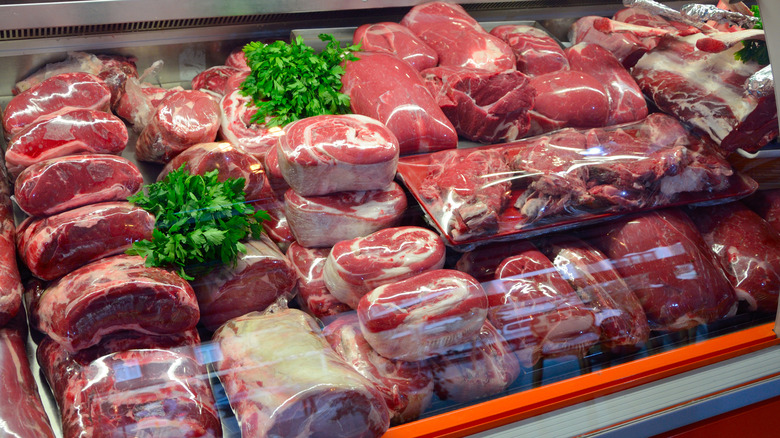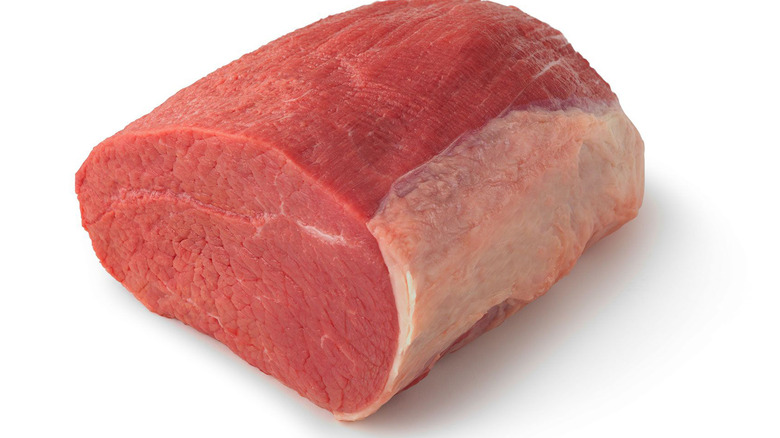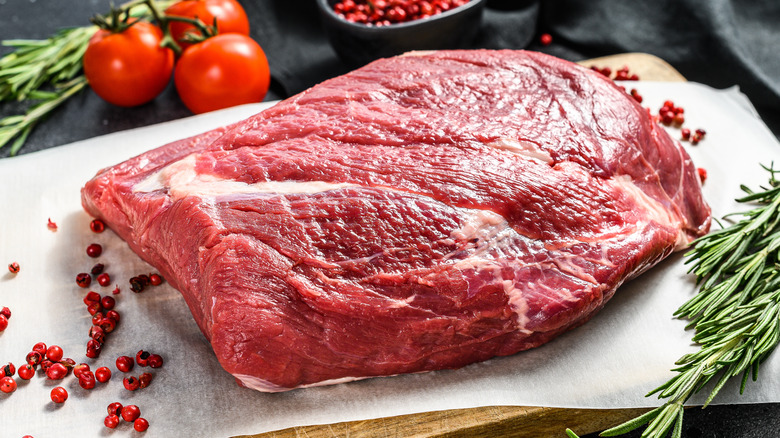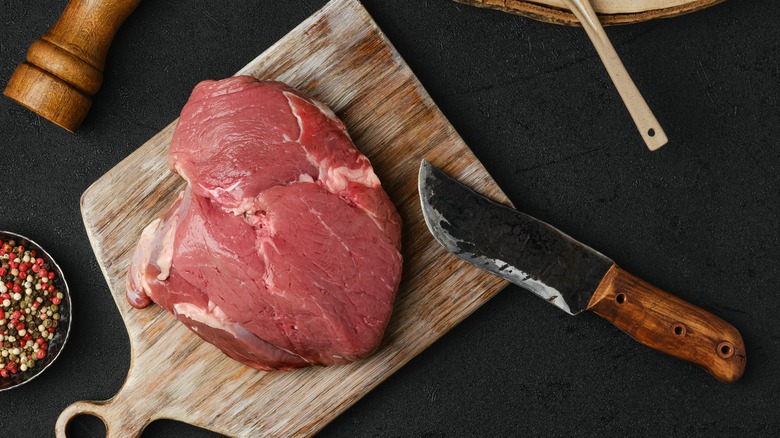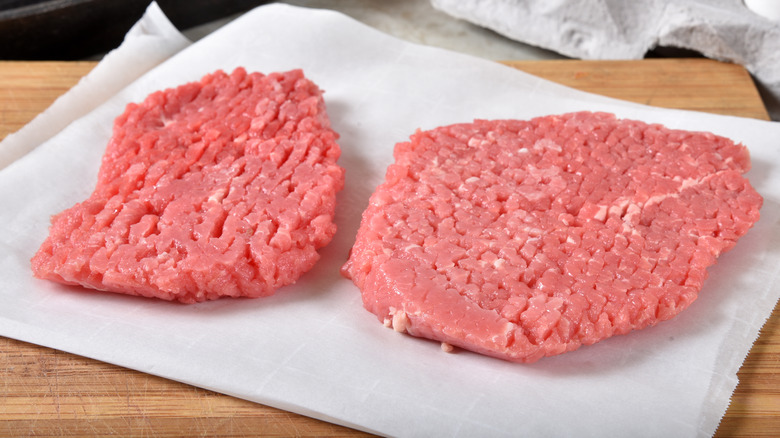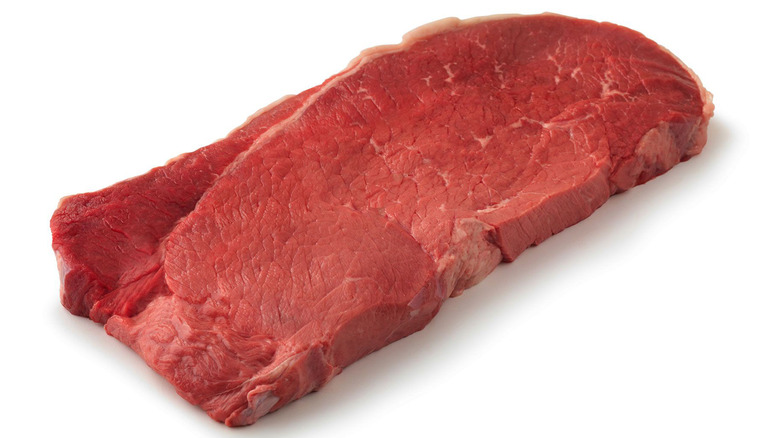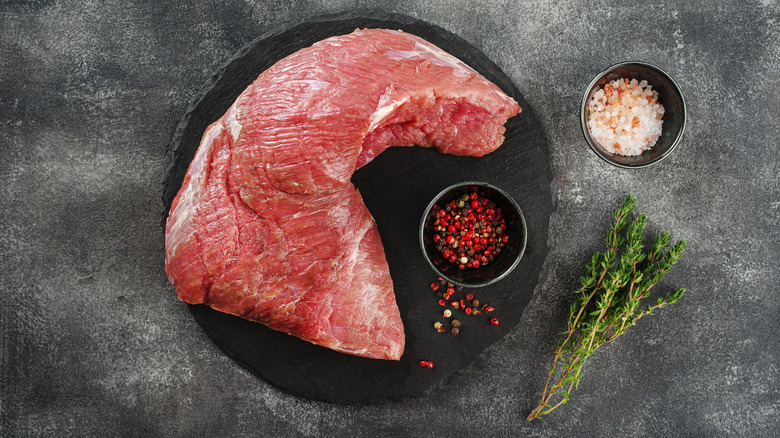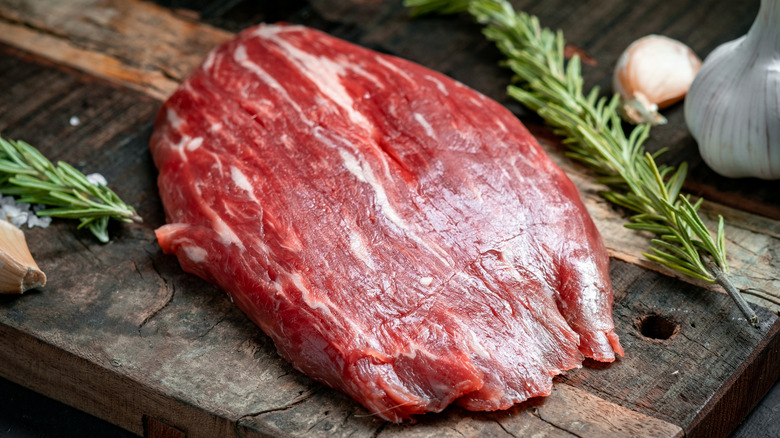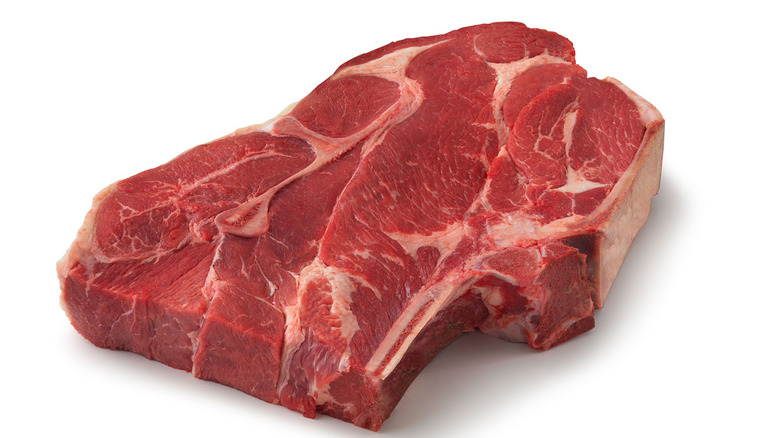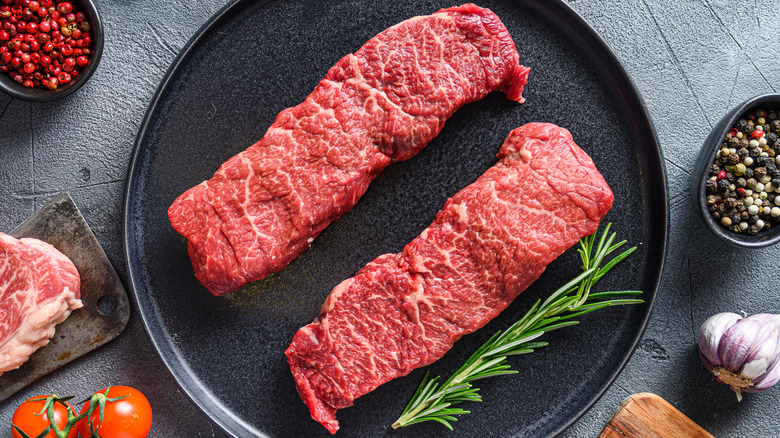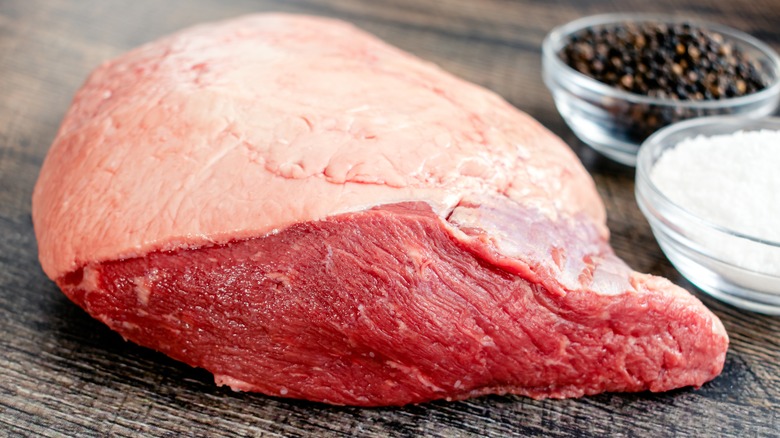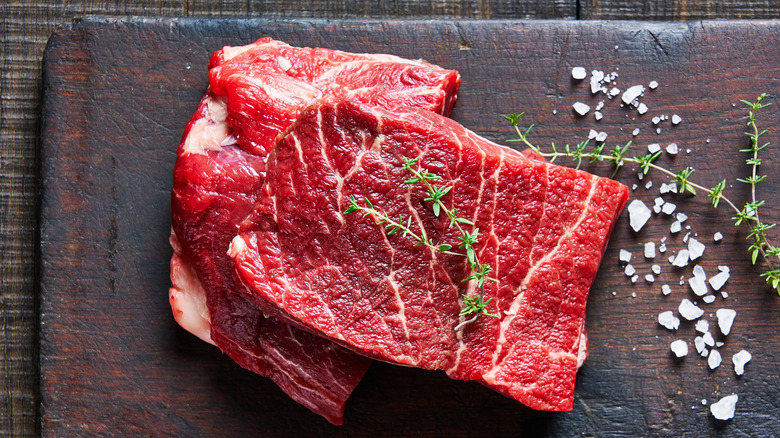Ranking The Cheapest Cuts Of Steak, From Worst To Best
Groceries just seem to be getting more and more expensive, and beef is no exception. Even before inflation started affecting grocery store visits, beef was kind of costly.
But part of the reason why steak is so expensive is that people tend to reach for traditional cuts of meat that come from a mere 10 percent of the animal (via Mel Magazine). At the risk of stating the obvious, cows are huge creatures, and there's plenty of meat on them besides the traditional ribeye, porterhouse, T-bone, and filet cuts you'll find at a steakhouse.
There are plenty of lesser-known, cheaper cuts that rival the old favorites in taste and tenderness. However, that doesn't mean that every piece of a cow is good eating, however, at least not in steak form. In addition to the hidden gems, you'll see supermarkets trying to sell cuts that have no business being cooked medium rare and served alongside a loaded baked potato.
These sorts of cheap steaks may be fine for stew meat or ground beef, but they will only lead to disappointment and frustration if you try to sear them like you would a nice steak. For value-minded beef cooks, it's essential to know which cuts of cheap steak are awful and which ones are awesome. The next time you're picking out steaks at the butcher counter, you should be armed with the necessary knowledge to ensure that you pick out a delicious hunk of beef that won't break the bank.
Eye of round
First, we'll start with the good attributes of eye of round: According to Beef. It's What's For Dinner, this cut is super cheap and not very fatty. As the butchers from Brooklyn meat shop The Meat Hook note in a YouTube video, the uniform shape of the eye of round means that it cooks super evenly. Its lack of bones also makes it easy and convenient to eat. That's about it for the good stuff.
Eye of round comes from a cow's hind leg, known as the round. The Meat Hook butchers say that leg cuts tend to have a strong beefy flavor, but the eye of round is bland compared to the other muscles in the leg. Furthermore, since the muscles in this portion of the leg get a lot of exercise, they tend to be on the tougher side.
According to MasterClass, eye of round is the toughest piece of meat in the whole round section. You can slow cook it to make it more tender, but that doesn't make up for its blandness. You can also cook it medium rare like a steak, but you'll have to be okay with spending a long time chewing on it.
Overall, it's just a bad cut of meat to use for steak. The comments section from The YouTube video referenced above does mention one application where eye of round shines: Apparently, this cut's lack of fat and uniform shape makes for excellent homemade beef jerky.
Bottom round
Bottom round, like eye of round, comes from a cow's leg (via MasterClass). Specifically, it's sourced from the outer edge of a cow's hind leg. You can slow cook it or braise it to make it tender, but it's also possible to cook it like a steak.
If you want to go that route, you shouldn't cook it to any temperature higher than medium rare to preserve what little tenderness is present in this cut of beef (via Certified Angus Beef). If you try to cook this well done, you might as well chew on a car tire. Slicing it as thin as possible can also make it easier to eat this tough cut.
If you really want to try to make bottom round tender, you can follow Viva Flavor's advice and beat it with a meat mallet and then soak it in a marinade for a long time. However, that's a lot of effort to put in to make this cut of beef palatable to eat as a steak, especially since there are better options out there.
Petite sirloin
The petite sirloin, as its name suggests, comes from the sirloin primal (via Beef. It's What's For Dinner). The sirloin is the rear part of the cow's torso, behind the loin section but in front of the leg/round. Many desirable cuts of steak come from the sirloin, but the petite sirloin isn't one of them. It is quite cheap, but you may find that it's not worth it, even for the modest price.
Petite sirloin steaks are cut from the bottom of the sirloin primal, close to the leg. That means that, like cuts from the round primal, petite sirloins are lean and fairly tough, per Food Fire Friends. This cut runs on the smaller side, generally measuring at around 6 to 8 ounces. It has a strong beefy flavor and is good for marinating, but unless you braise it, it's going to be a little bit chewy. When you're choosing a steak, you generally want something that can be grilled or seared quickly, and petite sirloin isn't great for that, though it is certainly edible when grilled.
Cube steak
Cube steak can refer to any number of cheap, tough, lean cuts of beef that have been mechanically tenderized (via Your Meat Guide). It's often made with various cuts of round, which tends to be pretty tough when cooked without tenderizing (via YouTube).
It's possible to make cube steak at home by slicing thin pieces of round and hammering them with a meat mallet, but you can also buy pre-prepared cube steak at most supermarkets. Supermarket cube steak is usually processed using a machine that slices into the meat at regular intervals, tenderizing it and giving it a waffle-like "cube" pattern.
You can cook cube steak in many different ways, but one of the most popular is to bread it and fry it to make chicken fried steak. One thing to keep in mind when preparing cube steaks is that you should always cook them well done. Mechanical tenderizing can potentially contaminate the interior of a piece of beef with bacteria, making it unsafe to eat rare or medium (via USA Today).
Pre-tenderized cube steaks can be used to cook some tasty dishes, but ultimately, they're still just undesirable pieces of mystery beef with a bunch of holes poked in them. Even for dishes like chicken fried steak, you're probably better off purchasing the specific cut you want and tenderizing it yourself.
London broil (top round)
Technically, London broil isn't a specific cut of meat (via TasteAtlas). Rather, it's a technique for making a tough cut of steak tender by marinating it, cooking it briefly, and slicing it thin. The technique was initially applied to flank steak. However, you may have noticed that your local grocer carries a cut of beef labeled as London broil that doesn't look anything like flank steak. What gives?
According to Food Fire Friends, top round steak is often sold as London broil. If you're going to eat steaks cut from the round primal, top round is the way to go. Like bottom round, it's leg meat, so it's heavy on beef flavor. Even better, it's a little more tender than the other parts of the leg. It's nowhere near as tender as expensive cuts like filet mignon or ribeye, but it's not nearly as tough as eye of round.
As with other lean cuts of beef, it's imperative not to overcook top round/London broil. Cook this steak rare/medium rare: Taking it off the heat at the right moment will ensure tenderness. Slicing it against the grain after cooking will also make it feel more tender. With top round, it's hard to go wrong with a classic London broil recipe, which follows the rules above and also uses an acidic marinade to help break down the meat a little bit.
Tri-tip
Tri-tip comes from the bottom sirloin, close to the petite sirloin. However, it's much, much nicer to eat than its sirloin neighbor. Chef David Guas described it to Thrillist as "the least-expensive, best taste of beef you can purchase."
Tri-tip is named after its distinctive triangular shape. It was formerly used mostly for ground beef, but it's wonderful when cooked up whole and served as a steak (via Steak School by Stanbroke). The best way to cook it is by using sort of a hybrid method that is between the low-and-slow method you'd use for brisket and the high-heat sear typical of steak cookery.
Tri-tip tastes wonderful when smoked until it reaches the proper internal temperature and then seared to create a crust on the outside. Unlike brisket, tri-tip is generally served medium rare, just like more typical steak cuts.
This cut is delicious, but it's also a little bit finicky. Like most cuts of steak, you want to avoid overcooking it. Its odd shape also makes it difficult to slice properly. The grain of the meat changes direction halfway through. If you fail to adjust your cutting angle and accidentally slice with the grain instead of against it, even perfectly-cooked tri-tip will end up tough and chewy.
Flank steak
Flank steak comes from a cow's abdominal section (via MasterClass). It's quite lean and has an unfair reputation for being tough. The texture of a piece of flank steak has everything to do with the skill of the person cooking it. It can be tough if the leather is mishandled, but it comes out wonderfully tender when prepared the correct way, according to the Kansas City Steak Company. Flank has a robust, beefy flavor, so it's an excellent cut of steak to eat if it's cooked with care.
There are two ways to cook a flank steak to make it tender. The first is to sear it or grill it quickly, cooking it to no more than medium (medium rare or rare is even better). After cooking, slice it against the grain to ensure a tender mouthfeel. Flank steak loves marinades, so it's never a bad idea to give it a bath before cooking.
Interestingly, even though well done grilled flank steak is a bad idea, flank tastes great when cooked for a long time in liquid. Braising or pressure cooking takes the flank steak past the point of well done and chewy and actually starts to break down the cut's tough muscle fibers, making it soft and succulent. So remember: When cooking flank, either do it for a really short time or a really long time. Anything in the middle will lead to sorrow.
Chuck steak
The chuck region is the cow's shoulder, in front of the ribs (via Steak University). The rib area is where fatty, tender, expensive cuts like the ribeye come from. The muscles in the chuck section get more exercise than those in the rib section, so they tend to be leaner and tougher. However, they have an intense, rich flavor that makes them some of the tastiest pieces of the whole cow.
Since chuck is a little bit tough, it's often used for braising or other slow-cooked preparations. It's ideal for pot roast recipes, for example. However, certain parts of the chuck can be cut into steaks that are tender enough to grill. According to MyRecipes, the chuck steaks cut from the top blade region can be especially tender if cooked properly.
ChefSteps has a technique that can turn any piece of chuck, even a tougher slice, into a melt-in-your-mouth grilled steak. To do it, you vacuum-seal your chuck steak and then cook it sous-vide at a low temperature for a very long time. The gentle heat breaks down the steak's connective tissue and softens it much like braising it would, but leaves the meat a pink medium-rare. After sous-viding, all you need to do is take the steak out of the bag, dry it off, and give it a quick sear on a hot grill.
Denver steak
Denver steak is a very specific cut of chuck. Since it comes from the shoulder, it's affordable, but it looks and tastes like steaks from more expensive parts of the animal. Although most of the chuck is relatively chewy because the muscles in a cow's shoulder support a lot of weight, the muscle that sits directly under the shoulder blade (the Denver steak) gets much less exercise than its neighbors (via Taste of Home). The Denver steak is shockingly tender (via Crowd Cow).
The marbling in the beef enhances the meat's texture and flavor, giving you a juicy, super-beefy bite. Many of the affordable cuts of steak are quite lean, and they don't have much marbling. They may taste great, but they lack the unctuous, rich quality of pricier cuts. The Denver steak's marbling makes it eat like a premium cut. If you close your eyes, you could convince yourself you're eating a New York strip.
The only issue with Denver steak is that it's little-known and kind of hard to find. You may have to visit a specialty butcher or shop online in order to get your hands on this cut. If you do find it, you should snap it up because it's uniquely delicious.
Picanha
This is another cut that might be a little tricky to find in the average grocery store, but if you do come across it, you are in for a treat. Picanha is the most popular cut of beef served at Brazilian steakhouses (via Texas de Brazil). It comes from the rump of the cow (the top of the cow's rear end), close to the sirloin.
You may find it in American stores labeled as "rump cap" or "sirloin cap," but to get your hands on one, there's a good chance you'll have to talk to a butcher. Although most of the muscles from a cow's hindquarters are relatively tough because they carry a lot of weight, the rump cap isn't a hardworking muscle, so it's quite tender (via Steak School by Stanbroke).
Picanha is pretty cheap, but it's wonderfully beefy, tender, and juicy. The meat itself is usually relatively lean, but it's crowned with a thick fat cap that melts as the meat cooks, lubricating everything with delicious beef fat.
Picanha starts out as a roast-sized cut, and it's usually carved into thick steaks and then skewered so it can be grilled churrasco-style. You can also grill it on a conventional American grill or roast or pan-sear it like any other cut of steak. Any way you cook it, this cut is heavy on delicious beef flavor, so it should be seasoned simply so that its inherent taste isn't covered up.
Flat Iron
Would it surprise you to learn that the second-most tender muscle (behind filet mignon) on a cow is a relatively affordable chunk of chuck? (via Omaha Steaks). Yes, it's true: The flat iron steak rivals the tenderloin in texture, and it comes from the top blade region of the chuck primal. While most of the chuck is well-exercised and rather tough, the top blade is melt-in-your-mouth soft.
However, until recently, this muscle was rarely cut into steaks because it has a tough, gristly piece of sinew running through the center. The flat iron steak was born from innovations developed by the University of Nebraska and the University of Florida. Researchers at those institutions figured out a way to remove the sinew from this tender muscle.
According to Cattlemen's Steakhouse, since flat iron steaks come from the chuck, they're not terribly expensive. The flat iron combines the bold, beefy flavor of chuck with the soft mouthfeel of more expensive cuts. A good flat iron is so tender that you should be able to cut it with a fork. Omaha Steaks notes that flat irons also have marbling that is comparable to a New York strip. It's just about the ideal steak-eating experience.
If you're having trouble finding flat irons at your local stores, keep your eye out for butler's steaks or oyster blade steaks; those are just different names for flat iron steaks.
